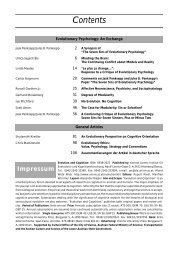Contents - Konrad Lorenz Institute
Contents - Konrad Lorenz Institute
Contents - Konrad Lorenz Institute
Create successful ePaper yourself
Turn your PDF publications into a flip-book with our unique Google optimized e-Paper software.
Michel A. Hofman<br />
other. An aspect cannot become conscious unless<br />
there is an essential node for it. For consciousness,<br />
there may be other necessary conditions, such as<br />
projecting to the frontal cortical areas. Thus a particular<br />
coalition is an active network, consisting of<br />
the relevant set of interacting nodes that temporarily<br />
sustain itself (CRICK/KOCH 2003). The smallest<br />
useful node may be a cortical column (MOUNTCASTLE<br />
1998), or perhaps, a portion of a cortical column.<br />
The feature which that node represents is (broadly)<br />
its columnar property. Recently, EDELMAN and<br />
TONONI (2000) presented a theory of consciousness,<br />
based on the idea of a ‘dynamic core’, which resembles<br />
the coalition concept to a large extent. The dynamic<br />
core hypothesis, however, rejects the idea<br />
that there is a special subset of neurons that alone<br />
expresses the neural correlate of consciousness, a<br />
view which is also defended in the present essay.<br />
Most of the theories of consciousness have the<br />
idea of competing assemblies of neurons in common.<br />
Consciousness depends on certain coalitions<br />
that rest on the properties of very elaborate neuronal<br />
networks. It is suggested that attention consists<br />
of mechanisms that bias the competition<br />
among coalitions, especially during their formation.<br />
Furthermore, the idea that the spatio-temporal<br />
dimensions of these nodes represent the neural correlates<br />
of mind is most appealing, as it suggests that<br />
consciousness, being an integral part of the species’<br />
problem solving capacity, correlates to some extent<br />
with the degree of complexity of a nervous system.<br />
Evolutionary Models of Mind<br />
Considering biological intelligence as the problem<br />
solving capacity of an organism makes it possible to<br />
speak of degrees of intelligence, and of its evolution<br />
from amoeba to man. But what does it mean precisely<br />
when one says that species differ in intelligence,<br />
or that vertebrates are in general more intelligent<br />
than invertebrates It means that there are<br />
differences in the abilities of organisms to perceive<br />
and interpret the physical world. Biological intelligence<br />
can thus be conceived as to reflect the temporal<br />
and spatial complexity of the species’ niche,<br />
without referring, however, to the kinds of situations<br />
organisms encounter in everyday life. It is, in<br />
fact, a measure of capacity, independent of the way<br />
the capacity is used, and it may be treated as a trait<br />
for ‘anagenetic’ rather than ‘cladistic’ analysis<br />
(GOULD 1976; JERISON 1985). It implies that when<br />
distantly related species are comparable in their<br />
problem solving capacity, we should consider the<br />
species to be comparable in biological intelligence.<br />
Yet the near equality in intelligence may be based<br />
upon radically different adaptations. Since neural<br />
mechanisms and action patterns evolve in the contexts<br />
of the environments in which they are effective,<br />
and since species never occupy identical<br />
niches, many and various intelligences (in the plural)<br />
must have evolved in conjunction with evolving<br />
environments (JERISON 1985).<br />
In theory, each ecological niche requires its own<br />
degree of biological intelligence. That means that<br />
specific neural and sensorimotor adaptations, always<br />
occur in relation to particular environments. A<br />
striking example is the mammalian brain, where<br />
the evolutionary changes in the balance of the sensory<br />
systems are the result of the adaptive radiation<br />
of species into many different ecological niches<br />
(PIRLOT 1987; MACPHAIL 1993). These sensory systems,<br />
like any other biological feature, could evolve<br />
as a result of natural selection, because any subject<br />
that forms inadequate representations of outside reality<br />
will be doomed by natural selection.<br />
In this view, cognitive systems and emotional<br />
phenomena can also be considered to be the result<br />
of interactions between genetic aptitude and natural<br />
environment, as they have a number of biologically<br />
useful functions: one is to keep track of the individual’s<br />
whereabouts in the world by constructing<br />
a schematic model of reality (POPPER 1982; WUKETITS<br />
1986). It is evident that the mind, as an emergent<br />
property of sufficiently complex living systems, has<br />
its evolutionary history like any other trait that increases<br />
adaptation to the environment, and that its<br />
functions have increased with the evolution from<br />
lower to higher organisms (POPPER 1972).<br />
Evolutionary psychology seeks to explain these<br />
evolved, functional characteristics of the human<br />
mind through the lense of an explanatory framework<br />
where special adaptive modules are postulated<br />
to have been critical for hominid survival and reproductive<br />
success (see PANKSEPP et al. 2002). These<br />
‘adaptive modules’ are theoretical constructs<br />
unique to the hominid lineage and should be<br />
clearly distinguished from the spatio-temporally defined<br />
neural processing units (or modules) of the cerebral<br />
cortex discussed in the present essay. The existence<br />
of a variety of genetically inherited,<br />
‘adaptive modules’, is dubious at best when considered<br />
simultaneously with our current understanding<br />
of mammalian brain organization. Indeed, the<br />
organization of the cerebral cortex, which is commonly<br />
assumed to be a prime anatomical substrate<br />
for unique cognitive functions, exhibits no robust<br />
Evolution and Cognition ❘ 184 ❘ 2003, Vol. 9, No. 2








